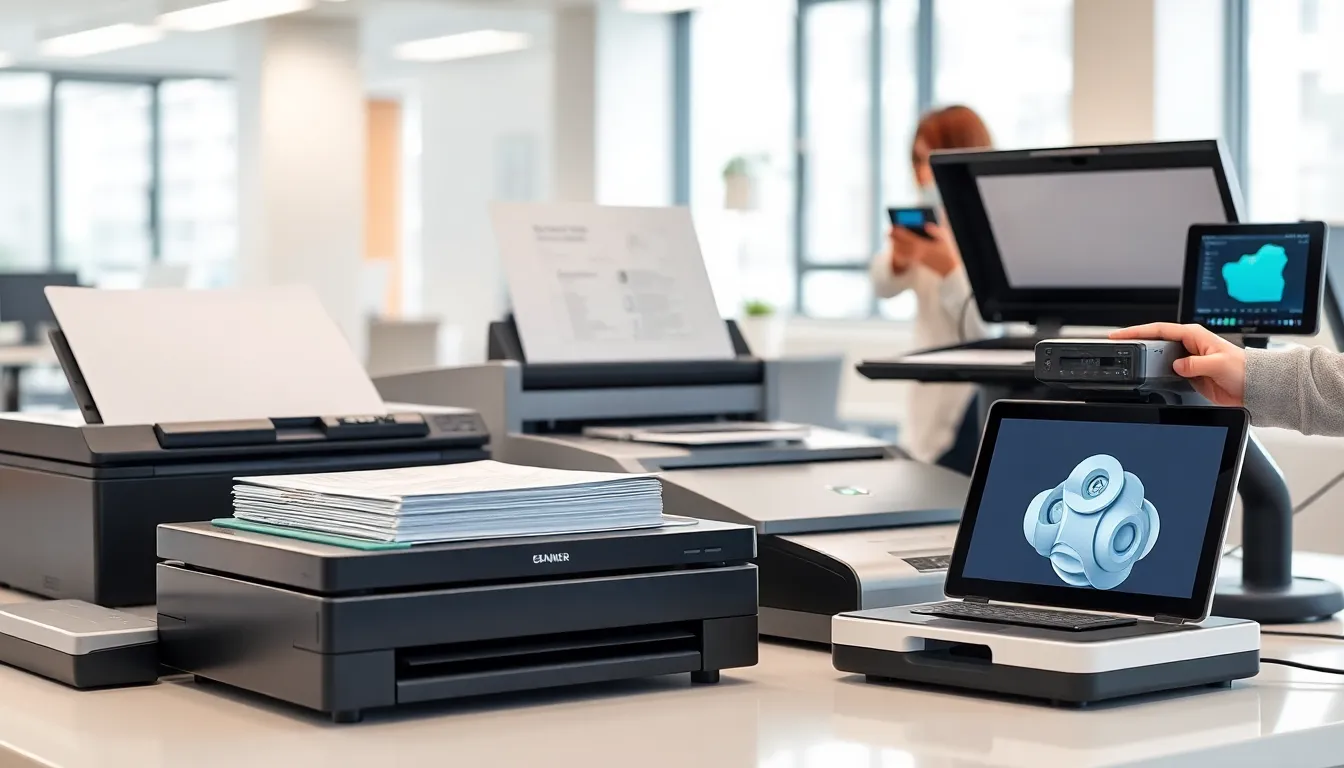Table of Contents
ToggleIn a world where paper piles up like laundry on a lazy Sunday, scanners swoop in like superheroes armed with the power to transform chaos into order. These nifty devices aren’t just fancy paperweights; they’re essential tools that bridge the gap between the physical and digital realms. With a gentle beep and a flash of light, a scanner can turn that mountain of documents into neatly organized files, making life a whole lot easier.
Whether it’s for business or personal use, understanding the role of scanners in the realm of computer hardware is crucial. They not only save time but also help keep your workspace clutter-free. So, if you’ve ever wondered how to tame the paper beast lurking in your office, it’s time to dive into the fascinating world of scanners and discover how they can revolutionize the way we manage information.
Overview of Scanners
Scanners serve as crucial hardware in the digital age. They convert physical documents into digital formats, making information easy to store and share. Many varieties exist, including flatbed, sheet-fed, and handheld scanners. Each type caters to different needs and preferences, offering versatility in scanning options.
Flatbed scanners excel at handling bound documents. Users can simply place books or magazines on a glass surface for scanning. Sheet-fed scanners, on the other hand, allow users to load multiple pages at once, automating the scanning process. Handheld scanners provide portability, enabling users to scan documents on the go.
Businesses often rely on scanners to streamline workflows. They digitize invoices, contracts, and reports, enhancing organization and accessibility. Personal users enjoy the benefits of scanning family photos and important documents for safekeeping. Composite usage of scanners supports cloud storage, facilitating seamless access across devices.
Speed and resolution vary between models, impacting usability. Scanners may deliver resolutions ranging from 300 to 1200 DPI, affecting image quality. Faster scanning speeds enhance productivity, especially in high-volume environments. Advanced features, like optical character recognition (OCR), further improve functionality by converting scanned text into editable formats.
Compatibility with software systems remains vital. Many scanners integrate smoothly with document management systems, enhancing user experience. Scanners now often connect via USB or Wi-Fi, offering flexibility in setup.
Recognizing the potential of scanners leads to improved information management. Investing in the right scanner considers both present and future needs, ensuring effective handling of electronic documentation. Overall, these devices contribute significantly to enhancing productivity at work and home.
Types of Scanners

Different types of scanners cater to various needs and preferences. Each type has distinct features that are beneficial in specific scenarios.
Flatbed Scanners
Flatbed scanners feature a glass surface that accommodates various document sizes. Users can scan books, photos, and thick materials easily by placing them on the flat surface. High-resolution capabilities ensure detailed images, making this type suitable for archiving valuable documents. The scanning process typically offers flexibility, as users can manipulate settings for clarity and color accuracy. Various models may also provide scanning options for both color and black-and-white documents, ensuring versatility in usage.
Sheetfed Scanners
Sheetfed scanners allow users to feed multiple pages into the device automatically. This design enhances efficiency, making it ideal for busy offices handling large volumes of documents. Scanning speeds often reach up to 60 pages per minute, significantly increasing productivity. Many sheetfed models also support duplex scanning, processing both sides of a page in one pass. Their compact design saves workspace, with some models supporting wireless connectivity for seamless integration into workflows.
Handheld Scanners
Handheld scanners provide portability and convenience for on-the-go scanning tasks. Users can easily scan documents, receipts, and even business cards without needing a stationary setup. Some models include rechargeable batteries, enhancing usability in various locations. Handheld scanners typically offer a simple interface, making scanning straightforward and fast. Their ability to save documents to various formats ensures compatibility with numerous devices, making them practical for diverse applications.
3D Scanners
3D scanners capture three-dimensional objects, creating digital models used in various industries. These scanners use laser or structured light technology to gather precise measurements, ensuring accuracy in the final output. Applications span across fields such as medicine, engineering, and entertainment. Many 3D scanners produce high-resolution models suitable for prototyping or archiving. As technology advances, new features enhance usability and broaden the scope of projects that can benefit from 3D scanning capabilities.
Key Features of Scanners
Scanners possess several essential features that enhance their functionality and meet diverse user needs.
Resolution and DPI
Resolution significantly impacts the clarity of scanned images. Measured in dots per inch (DPI), higher values result in clearer images. Most scanners range from 300 to 1200 DPI, offering flexibility for different tasks. Professionals requiring detailed images prefer higher DPI settings for intricate documents or photographs. For everyday scanning, 300 DPI typically suffices, balancing quality and speed. Advanced tasks often necessitate 600 DPI or more, particularly when capturing fine details.
Color Depth
Color depth determines how accurately a scanner reproduces colors. Measured in bits, it influences the range of colors a scanner can capture. Most standard scanners feature 24-bit color depth, which enables the display of approximately 16 million colors. Higher color depth, such as 48-bit, enhances the quality further, making it ideal for images requiring precision. Photographers and graphic designers often opt for scanners with elevated color depth to ensure vibrant and true-to-life representations. Selecting the appropriate color depth aligns with the intended use, balancing file size and quality.
Speed and Performance
Speed and performance play crucial roles in selecting a scanner. Scanning speeds, typically measured in pages per minute (PPM), can vary widely among models. Some sheet-fed scanners achieve speeds of up to 60 PPM, catering to high-volume demands. Scanners equipped with automatic document feeders (ADFs) enhance efficiency, allowing users to scan multiple documents without manual intervention. Performance also correlates with processing power; more advanced models handle larger files and complex tasks seamlessly. Prioritizing speed and performance ensures that scanning meets productivity expectations in both business and personal settings.
Uses of Scanners
Scanners play a vital role in various contexts, enhancing convenience and efficiency across multiple scenarios.
Home Use
Home users benefit significantly from scanners, transforming physical documents and cherished family photos into organized digital formats. Scanning allows individuals to declutter their living spaces while preserving important memories. With the ability to create digital backups, families can safeguard essential documents, like tax papers or insurance policies, against loss. Several household tasks, such as organizing recipes and school projects, become simpler with the help of a scanner.
Business Applications
In business environments, scanners streamline operations and promote effective document management. Many companies depend on scanners to digitize invoices, contracts, and reports, reducing physical storage needs. Scanners also enhance collaboration by enabling easy sharing of important documents among team members. They’re instrumental in boosting productivity, as some high-speed models can handle up to 60 pages per minute. As a result, businesses can quickly maintain essential records, ensuring compliance and improving workflow.
Archiving and Document Management
Effective archiving practices rely on scanners to maintain streamlined document management systems. Organizations utilize scanners to convert large volumes of paper records into searchable, digital formats, facilitating easier retrieval. This process reduces physical storage requirements and improves space utilization. Additionally, implementing optical character recognition (OCR) technology makes it possible to transform scanned text into editable files. Ultimately, digitized archives support better organization, enhance security, and ensure essential documents remain accessible over time.
Scanners play a pivotal role in modern document management. By converting physical documents into digital formats they enhance organization and accessibility for both personal and professional use. Their diverse types cater to various needs ensuring that users can find the right fit for their tasks.
With advanced features like high resolution and OCR capabilities scanners not only improve productivity but also streamline workflows. As technology continues to evolve the importance of scanners in reducing clutter and improving information management will only grow. Embracing these tools can lead to a more efficient and organized approach to handling documents in any setting.










